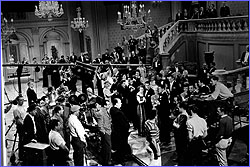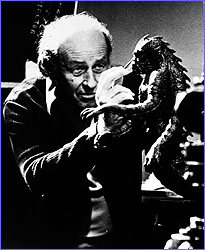
|
 |
 |
Special effects delight audiences in genres like fantasy ("Thief of Baghdad"), science fiction ("Dr. Cyclops') and war ("Flying Tigers"). But an increasing number of films in unlikely genres, like "Citizen Kane," "Rebecca," and "The Private Lives of Elizabeth and Essex," rely on invisible effects to tell dramatic stories. 1940 Alfred Hitchcock directs his second Hollywood feature, "Foreign Correspondent." A master of special effects, Hitchcock often used rear projection to bring exotic locales into the studio. For "Foreign Correspondent," Hitchcock and Lee Zavitz engineer a dramatic scene of a plane crashing into the ocean by using a rear projection of the ocean; on the plane's "impact," thousands of gallons of water are poured through the screen, flooding the set. 1945
Continue: 1950s Photos: Bison Archives Reel Timeline | 50-Foot Chicken | Wizards of Ahs | Be in Pixels Titanic: What's Real | Virtual Humans | Resources | Teacher's Guide Transcript | Site Map | Special Effects Home Editor's Picks | Previous Sites | Join Us/E-mail | TV/Web Schedule About NOVA | Teachers | Site Map | Shop | Jobs | Search | To print PBS Online | NOVA Online | WGBH © | Updated November 2000 |
 Alfred Hitchcock directs "Foreign Correspondent"
Alfred Hitchcock directs "Foreign Correspondent"
 Ray Harryhausen at work on stop-motion animation.
Ray Harryhausen at work on stop-motion animation.